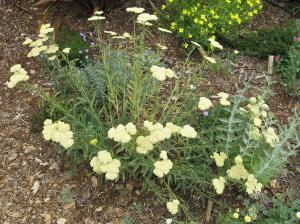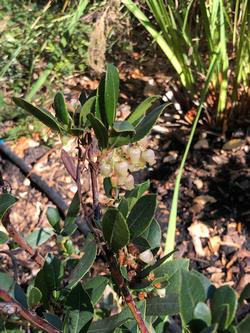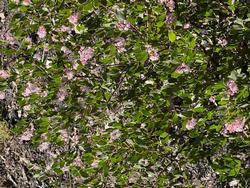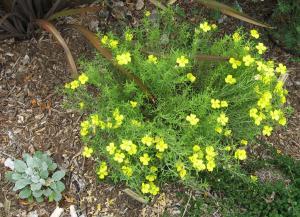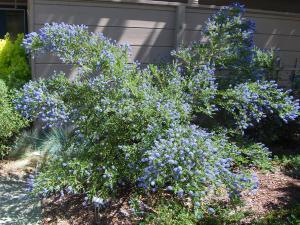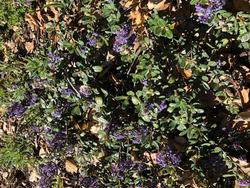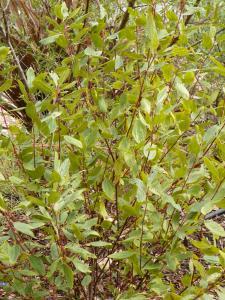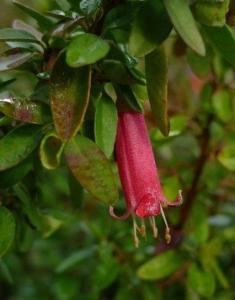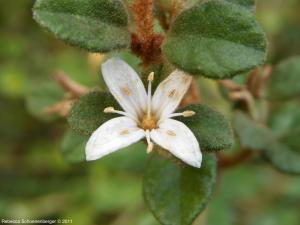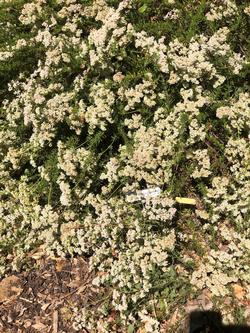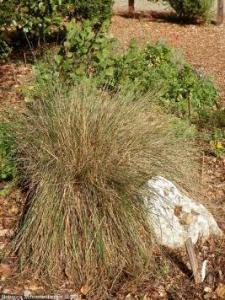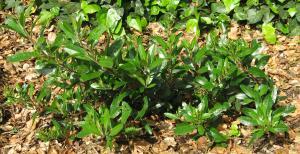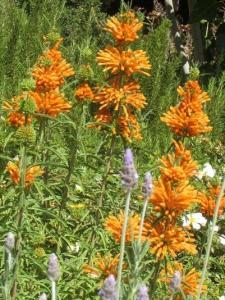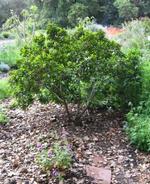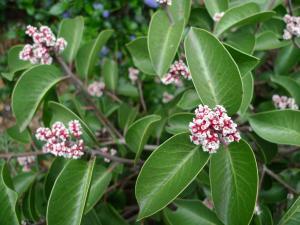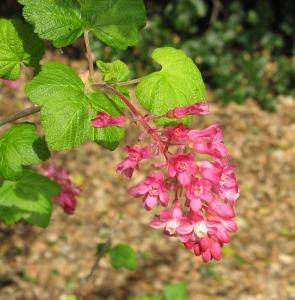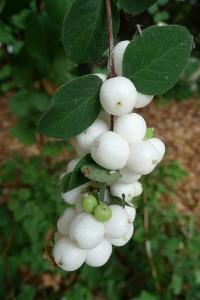Water Wise Plants
Here's a full list of all our water wise plants. You can also view an image gallery, or view the plants by categories.
Achillea ‘Taygetea’
Pronunciation
ah-KILL-lee-ah tay-GET-ee-uh
Common Name
Yarrow ‘Taygetea’
Plant Type
Perennial
Mature Size
12 in. to 18 in. wide and tall
Water Requirements
Low: water every three weeks until the root ball is wet
Sun/Shade Requirements
Full sun
Wildlife
Flower Color
Creamy yellow
Where to See
Maintenance- Design- Planting Tips
‘Taygetea’ Greek yarrow is a cheerful, reliable summer bloomer. The flowers start out bright yellow in midsummer and fade to a more mellow shade over time. The grey-green foliage blends in well with many plants found in low water gardens. This cultivar of yarrow seems to be more drought tolerant than the popular Achillea millifolium.
Greek yarrow doesn't need a great deal of maintenance. To encourage reblooming, deadhead it regularly. This plant will spread, so don't plant it too tightly. |
Arbutus unedo ‘Compacta’
Pronunciation
ar-BYOO-tus YOO-nee-doe
Common Name
Strawberry Bush
Plant Type
Tree
Mature Size
10' high x 10' wide
Water Requirements
Low: water every three weeks until the root ball is wet
Sun/Shade Requirements
Full to half sun
Wildlife
Flower Color
White
Where to See
Maintenance- Design- Planting Tips
Arbutus uneda or Strawberry Tree is a small tree with dark green leaves. It has dainty, white, bell-shaped flowers in the fall and winter. The flowers are followed by small, bright red fruits that somewhat resemble a strawberry. The fruit is enjoyed by birds and although not toxic to humans, they are not considered tasty. The fruit can be messy if the tree planted over sidewalks or patios. PADG notes: The tree was planted at PADG in 2020. It is currently doing well and is drip irrigated every two weeks during the dry season. As it matures it will need less water. |
Arctostaphylos densiflora ‘Howard McMinn’
Pronunciation
ark-toe-STAF-i-los den-si-FLOR-us
Common Name
Manzanita ‘Howard McMinn’
Plant Type
Shrub
Mature Size
5-7 ft tall x 6-10 ft wide
Water Requirements
Very Low: water deeply several times a summer
Sun/Shade Requirements
Full to half sun
Wildlife
Flower Color
Whitish pink
Maintenance- Design- Planting Tips
California native Arctostaphylos ‘Howard McMinn’ is reputed to be the manzanita most tolerant of typical garden conditions. Manzanitas in general need excellent drainage. In heavy clay soils, be careful not to over water or over fertilize.
If the tips of Arctostaphylos branches are pruned, this large shrub will become very dense and make a good privacy screen. Removing the interior stems and leaves instead exposes the interesting red bark. The latter is a good approach for making the shrub more of a focal point instead of a background plant. PADG notes: PADG planted three ‘Howard McMinn’ manzanitas at the entrance of the Water Wise Garden. They have struggled there over the years, damaged by foot traffic and the occasional joy rider. |
Artemisia douglasiana
Pronunciation
art-ee-MIS-ee-uh dug-las-ee-AH-nuh
Common Name
Douglas' Sagewort
Plant Type
Perennial
Mature Size
4 ft (1.2 m) wide x 8 ft (2.4 m) tall
Water Requirements
Moderate: water weekly until the root ball is wet
Sun/Shade Requirements
Half sun to shade
Wildlife
Flower Color
Cream, White, Yellow
Where to See
Maintenance- Design- Planting Tips
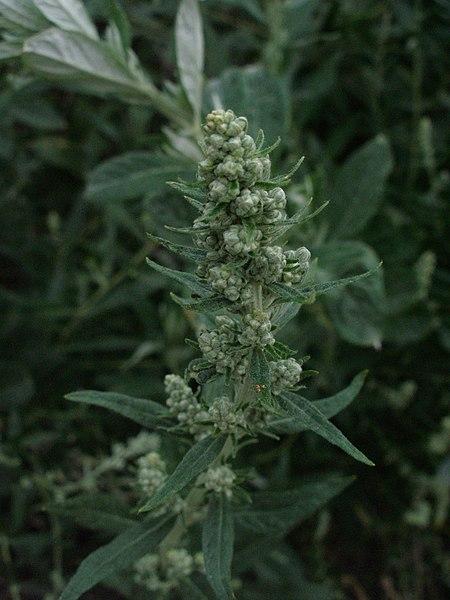
|
Calylophus hartwegii
Pronunciation
kal-ee-LOW-fus heart-WEHG-ee-eye
Common Name
Sundrops
Plant Type
Perennial
Mature Size
1.5 ft. high and 2 ft. wide
Water Requirements
Low: water every three weeks until the root ball is wet
Sun/Shade Requirements
Full to half sun
Wildlife
Flower Color
Where to See
Maintenance- Design- Planting Tips
Calylophus hartwegii is a showy, low growing perennial. The flowers, which appear in mid-summer, are bright yellow. The delicate, lacy foliage is also an attractive addition to the garden. It is native to the southwestern US and northern Mexico.
Sunset’s Western Garden Book suggests shearing before spring growth. The stems on these plants can become woody. |
Ceanothus ‘Concha’
Pronunciation
see-a-NO-thus
Common Name
California Wild Lilac ‘Concha’
Plant Type
Shrub
Mature Size
6-8 ft tall x 6-8 ft wide
Water Requirements
Very Low: water deeply several times a summer
Sun/Shade Requirements
Full to half sun
Wildlife
Flower Color
Blue
Where to See
Maintenance- Design- Planting Tips
Ceanothus ‘Concha’ is a California native plant with rose colored buds that open to cobalt blue flowers in late winter or early spring. Leaves are small and a deep dark green.
‘Concha’ is one of the best Ceanothus cultivars for Santa Clara County. It is more adaptable to typical garden environments than many other Ceanothus, tolerating heavy clay soil, drought, or summer watering. Overwatering will shorten the life of any Ceanothus so be sure to allow the soil to dry between waterings. |
Ceanothus maritimus ‘Valley Violet’
Pronunciation
see-an-OH-thus muh-RIT-tim-mus
Common Name
Maritime ceanothus
Plant Type
Shrub
Mature Size
1'-3' high x 3'-8' wide
Water Requirements
Low: water every three weeks until the root ball is wet
Sun/Shade Requirements
Full sun
Wildlife
Flower Color
Maintenance- Design- Planting Tips
Ceanothus maritimus ‘Valley Violet’ is a California native and a UC Davis Arboretum All-Star. This low growing Ceanothus has a wide spread and can be an effective ground cover. It has dark, blue-green foliage that contrasts nicely with its purple flowers, which bloom from winter into spring. Be aware that all Ceanothus develop buckthorns as they age that can be very sharp.
PADG notes: Several varieties of Ceanothus were planted several years ago in the Native Bed at the Palo Alto Demonstration Garden. As of 2022, Ceanothus maritimus ‘Valley Violet’ is doing the best in the group. It is very drought tolerant and is living up to its All-Star status with the garden’s dry season irrigation cycle. Established plants are watered once every three weeks with drip lines. |
Ceanothus x pallidus ‘Marie Simon’
Pronunciation
see-an-OH-thus PAL-id-us
Common Name
Wild Lilac ‘Marie Simon’
Plant Type
Shrub
Mature Size
Up to 6 - 8 ft. high and wide
Water Requirements
Low: water every three weeks until the root ball is wet
Sun/Shade Requirements
Full to half sun
Wildlife
Flower Color
Where to See
Maintenance- Design- Planting Tips
Ceanothus x pallidus ‘Marie Simon’ is a cross between a native Ceanothus and another unknown plant, and is a UC Davis Arboretum All-Star. It looks quite different from a native Ceanothus. It is semi-deciduous, with red stems and light green leaves, and its flowers are a delicate pink instead of the blue more typical for Ceanothus.
PADG notes: Online photos show a plant covered with pink flowers but that hasn’t been the case at the Demonstration Garden. The flowers have been pretty but sparse and the plant does not look vigorous. It has been in the garden for several years and is still a non-performer. We can’t recommend this plant for low water gardens in the Palo Alto area. |
Correa ‘Dusky Bells’
Pronunciation
KOR-ree-uh
Common Name
Australian Fuchsia
Plant Type
Shrub
Mature Size
6 ft. to 8 ft. wide and 2 ft. to 3 ft. tall
Water Requirements
Low: water every three weeks until the root ball is wet
Sun/Shade Requirements
Full to half sun, shade
Wildlife
Flower Color
Reddish pink to red, cream, orange, and greenish yellow
Where to See
Maintenance- Design- Planting Tips
Correa has many attributes that make it ideal for Bay Area gardeners. It thrives in sun, partial sun, or shade; is deer resistant and bird friendly; has pretty, long-lasting flowers that provide winter color; does well with moderate to occasional water; does not get too big; tolerates our alkaline soil; and is evergreen.
Also, the shrub requires no deadheading or pruning, so it is practically maintenance-free. Look for some of the newer cultivars of Correa that have been bred to produce more visible flowers above the foliage. |
Correa alba
Pronunciation
KOR-ree-uh AL-ba
Common Name
Australian Fuchsia, White
Plant Type
Shrub
Mature Size
8 ft. high and wide
Water Requirements
Low: water every three weeks until the root ball is wet
Sun/Shade Requirements
Full to half sun, shade
Wildlife
Flower Color
Where to See
Maintenance- Design- Planting Tips
Correa alba looks very different from the more commonly grown Correa ‘Dusky Bells’. The flowers are more open and less downward facing than other Correas. The foliage is fuzzy on the back side and the stems are bronzy brown. This shrub can grow to 8 feet by 8 feet without regular pruning.
Like Correa ‘Dusky Bells’, Correa alba thrives in sun, partial sun, or shade; is deer resistant and bird friendly; and has long-lasting flowers. The plant does well with moderate to occasional water, tolerates alkaline soil, and is evergreen. The plant is sensitive to overwatering and overfertilizing. PADG notes: Some find Correas to be short-lived but at the Palo Alto Demonstration Garden, this plant is still going strong after several years in the garden. The beds in garden are mulched with wood chips, but not fertilized and watered deeply with drip irrigation once every three weeks. |
Eriogonum fasciculatum
Pronunciation
er-ih-OG-uh-num fas-sik-yoo-LAH-tum
Common Name
California buckwheat
Plant Type
Shrub
Mature Size
2' high x 4'-5' wide
Water Requirements
Low: water every three weeks until the root ball is wet
Sun/Shade Requirements
Full sun
Wildlife
Flower Color
Maintenance- Design- Planting Tips
Eriogonum fasciculatum is a drought-tolerant California native shrub. Reaching only two feet in height with a four-to-five-foot spread, it is a good mid-border choice. The shrub has many branches that are densely covered with small, dark green, needle-like leaves and is covered with pinkish-white clusters of tiny flowers in spring which turn an attractive rust color in summer and fall. When not flowering, it is an attractive contrast to other plants in the mixed border. Trim flowers off when they become unsightly and lightly shape the plant. Do not prune heavily.
|
Festuca californica
Pronunciation
fess-TEW-kuh kal-ih-FOR- nih-kuh
Common Name
California Fescue
Plant Type
Grass
Mature Size
2 ft. high and wide, with inflorescence 2 - 3 ft. high
Water Requirements
Very Low: water deeply several times a summer
Sun/Shade Requirements
Full to half sun, shade
Wildlife
Flower Color
Golden
Where to See
Maintenance- Design- Planting Tips
Festuca californica is a commonly planted California native grass. It is larger than many of the Festucas, reaching two feet or more in height and has a softer more arching habit. Unlike many California natives, this plant can take moderate water and will stay green and lush with regular watering. Without regular summer watering, it will go dormant. Festuca californica is tough and resilient. To prevent reseeding, be sure to deadhead in early summer.
|
Heteromeles arbutifolia
Pronunciation
het-er-OH-mi-lees ar-bew-ti-FO-lee-a
Common Name
Toyon
Plant Type
Shrub
Mature Size
10-20 ft tall x 10-15 ft wide
Water Requirements
Very Low: water deeply several times a summer
Sun/Shade Requirements
Full to half sun
Wildlife
Flower Color
White
Maintenance- Design- Planting Tips
Toyon is an attractive dark green, large shrub that can develop into a small multi-trunk tree. This plant is native to many chaparral areas of California and easily adapts to garden cultivation.
It is a member of the rose family, producing small white flowers in early spring followed by showy red berries. The berries remain on the shrub for several months while they slowly ripen. Once ripe, they attract many different species of hungry, grateful birds. Young toyons may take a few years to settle into the garden but once established, they are easy to grow and can be pruned to manage their size or to keep them looking fresh. PADG notes: The toyon in the Palo Alto Demo Garden Water Wise Garden was planted in the winter of 2008 from a one-gallon container in a spot where it gets afternoon shade. This toyon is still a modest sized shrub many years after planting. |
Leonotis leonurus
Pronunciation
lee-oh-NO-tus lee-oh-NURE-us
Common Name
Lion’s Tail
Plant Type
Shrub
Mature Size
4 ft. to 6 ft. wide and tall
Water Requirements
Low: water every three weeks until the root ball is wet
Sun/Shade Requirements
Full sun
Wildlife
Flower Color
Orange-red
Where to See
Maintenance- Design- Planting Tips
This upright shrub from South Africa has bright eye-catching orange flowers. A single lion’s tail works well as a late summer/early fall garden focal point. The flowers can also be stunning in a flower arrangement.
Prune these shrubs in the early spring after the danger of frost is past to control size. Some gardeners prune them down to six inches from the ground; others just cut off half of the total height. How much to prune is a matter of deciding the desirable size of the plants in the garden. With no pruning at all, these plants can get very large, very quickly. Lion’s tail can be frost tender, but they rebound quickly. If this plant does get frost damaged, wait until after the danger of frost is past, then cut off the damaged parts. |
Rhamnus californica 'Mound San Bruno'
Pronunciation
RAM-nus kal-ih-FOR-nik-uh
Common Name
Coffeeberry 'Mound San Bruno'
Plant Type
Shrub
Mature Size
5 ft. tall and wide
Water Requirements
None: avoid summer water
Sun/Shade Requirements
Full to half sun, shade
Wildlife
Flower Color
Inconsequential pale yellow
Where to See
Maintenance- Design- Planting Tips
Coffeeberry isn't a flashy shrub, but it does add much needed structure to the native plant bed. The berries on the plant are attractive and beneficial for birds and small mammals.
There are many different varieties of coffeeberry. They can be used as an informal hedge or screen or gently pruned to be a bedding or foundation shrub. 'Mound San Bruno' has a compact growing habit that works well in a perennial bed. PADG notes: The California native coffeeberry 'Mound San Bruno' was planted in a native plant bed that receives both sun and shade. The amount of sun the bed gets varies depending on the time of year and time of day. That's a common condition in many gardens and not all shrubs do well in both sun and shade. The coffeeberry was watered once a week to get it started, but now that it is established, it is only watered once or twice over the summer to wash the dust off the leaves. |
Rhus ovata
Pronunciation
rus oh-VAY-tuh
Common Name
Sugar Bush
Plant Type
Shrub
Mature Size
8 ft. to 12 ft. tall and wide
Water Requirements
Low: water every three weeks until the root ball is wet
Sun/Shade Requirements
Full to half sun
Wildlife
Flower Color
Where to See
Maintenance- Design- Planting Tips
The California native, Rhus ovata, is an adaptable plant in the garden. This evergreen shrub can be pruned up by removing the bottom branches to create a small tree. It can also be formed into a hedge or left to grow naturally as a large, rounded shrub. Rhus ovata takes sun or partial shade and tolerates occasional water in the summer.
This plant is more of a garden workhouse rather than a star, but a garden full of stars would be overwhelming. These are good background shrubs for places that get no irrigation. The flower bracts, which appears in the fall, are red and show up well against the shiny green leaves. The flowers appear several months later and are small and white. |
Ribes sanguineum
Pronunciation
RY-beez san-GWIN-ee-um
Common Name
Pink Flowering Currant
Plant Type
Shrub
Mature Size
5 ft. to 12 ft. tall and wide
Water Requirements
Low: water every three weeks until the root ball is wet
Sun/Shade Requirements
Half sun to shade
Wildlife
Flower Color
Pink, red, yellow, white
Where to See
Maintenance- Design- Planting Tips
Ribes sanguineum is a useful landscape plant because it is one of the few shrubs that shine in dry shade. Pink Flowering Currant is one of the first plants to awaken in the spring with a beautiful display of pendulous pink flowers and green maple-like lobed leaves. Ribes, a deciduous shrub, loses all its leaves in the late fall.
This plant can be used as a focal plant in the garden surrounded by smaller perennials or as an understory plant when combined with large trees with low water usage, like California Oaks. It can get by with very little water but looks fuller when a moderate amount of water is applied in the summer. When using Ribes under a California Oak, avoid summer water. There are many different cultivars of Ribes available with flowers ranging from red to pink to yellow to white. Some types of Ribes work well in full sun. Hummingbirds are attracted to the flowers, especially since they bloom when not much else is flowering. In the fall the shrub has blue-black berries that attract fruit-eating birds including mockingbirds and cedar waxwings. Ribes sanguineum is found along the Pacific coast from California to British Columbia, Canada. |
Rubus parviflorus
Pronunciation
ROO-bus par-VEE-floh-roos
Common Name
Thimbleberry
Plant Type
Shrub
Mature Size
4 - 8.2 ft. (1.2 - 2.5 m) tall
Water Requirements
Moderate: water weekly until the root ball is wet
Sun/Shade Requirements
Half sun to shade
Wildlife
Flower Color
White, Yellow
Where to See
Maintenance- Design- Planting Tips
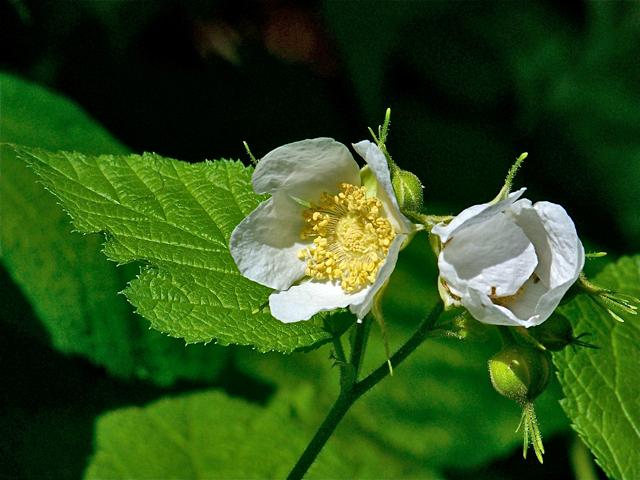
|
Scrophularia californica
Pronunciation
skrof-ew-LAH-ree-uh kal-i-FOR-ni-kuh
Common Name
California Bee Plant
Plant Type
Perennial
Mature Size
6 - 12 in (15 - 30cm) wide x 2 - 4 ft (0.6 - 1.2 m) tall
Water Requirements
Low: water every three weeks until the root ball is wet
Sun/Shade Requirements
Half sun
Wildlife
Flower Color
Red
Where to See
Maintenance- Design- Planting Tips
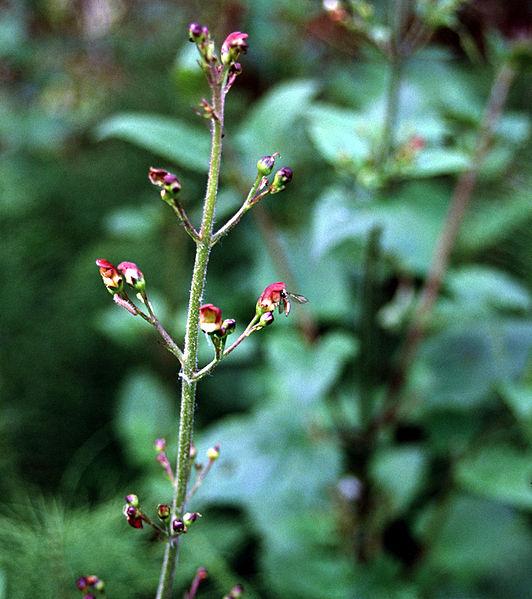
|
Symphoricarpos albus
Pronunciation
sim-for-ih-KAR-pus AL-bus
Common Name
Snowberry
Plant Type
Shrub
Mature Size
3 - 5 ft. tall and wide
Water Requirements
None: avoid summer water
Sun/Shade Requirements
Full to half sun, shade
Wildlife
Flower Color
Where to See
Maintenance- Design- Planting Tips
When fall and winter come, shrubs with berries and fruit add interest to the garden. Snowberry, a California native, has white berries that show up in the fall and last through winter. These berries are attractive to birds too.
One of the best features of snowberry is it does well in dry woodland conditions. It is a rare shrub that will thrive under a thicket of oak trees. Some people find the branching structure of snowberry to be messy. California Native Plants for the Garden recommends occasional coppicing to improve its appearance. Coppicing means to cut back a plant to about one foot from the ground. This usually works best right before a plant puts out new growth in the spring. PADG Notes: Our snowberries grow in a shady area that gets no summer irrigation.
|
Symphyotrichum chilense
Pronunciation
sim-fee-OT-ri-koom chi-LEN-see
Common Name
California Aster (Pacifc Aster)
Plant Type
Perennial
Mature Size
3 ft (0.9 m) wide x 1.3 - 3.3 ft. (0.4 - 1 m) tall
Water Requirements
Low: water every three weeks until the root ball is wet
Sun/Shade Requirements
Full to half sun
Wildlife
Flower Color
Blue, Lavender, Yellow
Where to See
Maintenance- Design- Planting Tips
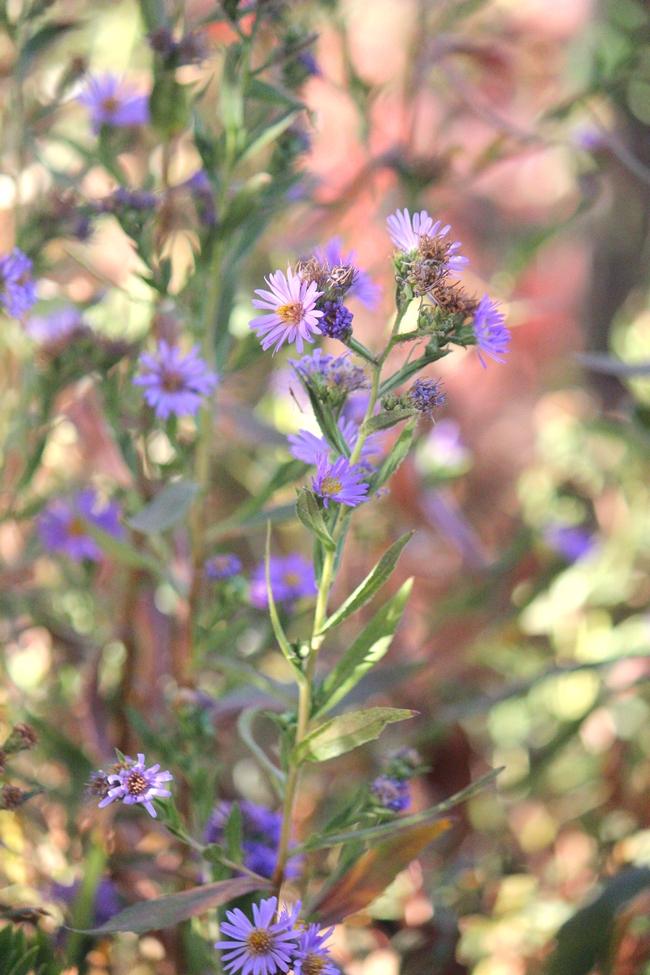
|







